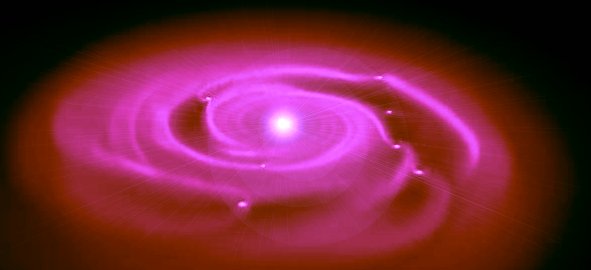
Brown Dwarfs
Until fairly recently our knowledge of stars and planets was pretty straightforward. Stars shone, emitting light by hydrogen fusion processes, and planets were dark objects orbiting them. This was simply common sense. No one spent too many sleepless nights worrying about what would happen when a object, undergoing the process of gas accretion to form a star or planet, would end up with mass somewhere in between. There is a critical size of about 80 Jupiter masses where such a body can sustain hydrogen fusion due to the temperatures and pressures generated by its own gravity (1). Then a star is born.

The formation of planets is less well understood, and the emerging discoveries of extra-solar planets are challenging astro-physicists to revise their theories. Nevertheless, when a planet is forming, up to several Jupiter masses in size, then it remains simply that; a planet. As the mass increases, things start to get more complicated.
Sagan, Shapley & Marley
The concept of brown dwarfs has been banded about for some time, although no reliable astronomical data has been available until quite recently. Carl Sagan enigmatically quotes a 1950s description of a brown dwarf in his 1995 book "Pale Blue Dot":
"In the 1950s, it was suggested by the astronomer Harlow Shapley of Harvard that brown dwarfs - he called them "Lilliputian stars" - were inhabited. He pictured their surfaces as warm as a June day in Cambridge, with lots of area. They would be stars that humans could survive on and explore."(2)
What makes this quote strange is that Sagan’s knowledge of the nature of brown dwarfs must have been vastly superior to this dated, naïve view of Shapley’s. So why use it when it was obviously so misleading? He didn’t mitigate this with offering a more modern viewpoint of the nature of failed stars. I posed this question to Dr Mark Marley, an academic specialising in the study of brown dwarfs, and this was his reply:
"I looked up the quote in the book and agree with you that it really isn't relevant.But when Sagan wrote the book there was only indirect evidence of brown dwarfs. Today we know they exist and know that indeed they are much like Jupiter. When he wrote the book, it was possible, though not likely, that brown dwarfs could be somewhat earth-like. We know today this is not the case. If I were writing the book, knowing what was known at that time, I would not have included the quote. Note that while brown dwarfs are not inhabitable, they might have moons that might be inhabitable." (3)
Quite so. I should state here that Mark Marley is not endorsing my work in any way, and was just giving me a few helpful answers to my questions regarding brown dwarfs. His answer does include this invaluable statement that life could be possible on the moons of a brown dwarf, however.
When Brown means Red
The term "brown dwarf" was first used by Jill Tarter, of the SETI institute, in her 1975 PhD thesis, in order to correct the use of the previous term "black dwarf". As she says:
"The use of the term ‘black dwarf’ was inappropriate because it had already been used to describe the end phase of a fully evolved star as it cooled from the white dwarf stage." (1)
Brown dwarfs are very difficult to find. They "glow only faintly", emitting most of their radiation in the infra-red bands. This is because they are below the 0.08 solar-mass stellar limit, and fail to ignite as stars in their own right. Instead, they emit radiation from energy left over from their formation. During the life-span of a brown dwarf, the younger they are ,the brighter they appear.
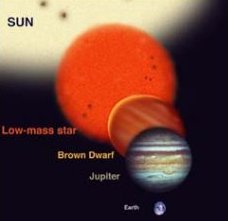
So we have more chance of discovering brown dwarfs that have just formed. As they get older, they start to appear more like Jupiter, only much more massive. In general, a brown dwarf’s luminosity is expected to be about a hundred thousandth of the Sun’s (4).Its spectral characteristics are different to those of very cool stars, unusually showing an absorption line of the short-lived element lithium.
Contrary to the description implied by its name, brown dwarfs appear red, very red. A brown dwarf was discovered in the Solar vicinity by Maria Theresa Ruiz of the European Southern Observatory in 1997, a discovery that offers the potential for much better study of these elusive objects. She called it KELU-1, the term for ‘red’ in the language of the indigenous population of central Chile.
Although it is at a distance of 33 light-years, its visual magnitude is 22.3, which is the sort of brightness projected for Murray’s proposed brown dwarf in the Oort cloud. This sets a precedent for its discovery. (5)
Brown Dwarf Discoveries
The best known brown dwarf, and one that we can actually look at through an Earth-bound 60-inch telescope, is Gliese 229B, discovered in 1995. This one is in a binary system with the low-mass red dwarf Gliese 229A, at a distance of just 19 light-years from the Sun.
The separation between the brown dwarf and its companion star is about the same as that between the Sun and Pluto. Its luminosity is about one tenth of the faintest star. Its spectrum has large amounts of methane and water vapour. Methane could not exist if the surface temperature were above 1500K.

Astronomers consider its temperature to be about 900K (compared to Jupiter’s 130K), its mass to be between 20 and 55 Jupiters, and the age of the binary system to be between 1 and 5 billion years old. It has a smoggy haze layer deep in its atmosphere, essentially making it "much fainter in visible light than it would otherwise be".
It is possible that ultra-violet light from its companion star changes its atmospheric properties from those of an isolated brown dwarf, such as KELU-1. (1) The above image shows 3 brown dwarfs compared with Jupiter, the Sun and the red dwarf Gliese A (6). Note the much higher temperatures of these brown dwarfs compared to Jupiter.
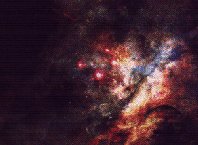
So brown dwarfs emit visible light, albeit faintly, but are cool enough to retain a planet like atmosphere! Stars and planets no longer appear to be entirely different entities. Imagine living on a moon of a brown dwarf : the dark star would be emitting red light and heat, yet it would appear like Jupiter regarding size and atmospheric consistency. Rather like Jupiter on fire, perhaps! Your moon would not only be warmed by the intense infra-red emitted from the brown dwarf, but also by its tidal effects (like Io and Europa are warmed by the otherwise cool Jupiter), and by its ambient red light.
If your moon was terrestrial, in other words had aqueous oceans and a nitrogen-rich atmosphere, could not the emergence of life there be entirely possible? Mark Marley seems to think so. Without the dangerous ultra-violet radiation and cosmic rays emitted by the Sun, one could argue that this sort of environment is actually preferable to the environment on Earth!
Coronal Flares
On 11th July, Reuters released news about the surprising discovery of a ‘Solar Flare’ emitted by a near-by brown dwarf, known as LP 944-20. These new findings seem to back up the assertion that brown dwarfs can act like stars as well as planets, albeit on a different level of magnitude than our Sun. Note that the brown dwarf in question is quite a sizeable one, however, and would be expected to be more star-like than one that is only a few times the size of Jupiter. Nevertheless, this type of activity is clearly evident on a failed star that is incapable of sustaining its own nuclear fusion:
"A famous failed star known as a brown dwarf sent out a surprising X-ray flare, astounding scientists who were expecting nothing more than a few flickers, U.S. researchers said on Tuesday. The dwarf in question, known as LP 944-20, is one of the best known and most studied by astronomers because it is just 16 light-years from Earth. This is quite close in cosmic terms, but because brown dwarfs are so dim, it is visible from Earth -- with a telescope -- only as a tiny dot of light. However, scientists can learn about these dim objects by observing the X-rays they emit. This brown dwarf has a mass about 60 times the mass of Jupiter but only 6 percent of the Sun's mass, putting it under the threshold of mass that could make it a real star.

Using NASA's orbiting Chandra X-Ray Observatory, astronomers watched LP 944-20 over a 12-hour period last December. For the first nine hours, they saw no X-rays, then detected a dramatic flare before it faded away over the next two hours. The flare was comparable to a small solar flare, but a billion times greater than X-ray flares detected emanating from Jupiter, the National Aeronautics and Space Administration said in a statement.
Lars Bildsten of the University of California, Santa Barbara, said the flare is probably related to tangled magnetic fields beneath the surface of the brown dwarf, which seem to be able to generate X-rays.
Brown dwarfs `appear to live a more exciting life than we presumed,'' Bildsten said in a telephone interview. `They are too big to be planets and two small to be stars, but it does appear that if you watch one it has very active events ... there is action going on.'' The X-ray flare the scientists saw was far beyond what scientists had expected, Bildsten said in a statement: `It was as if we were searching for a dim bulb and instead found a bright flash of light.'' (7)
This evidence is in keeping with my proposals about the Dark Star Nibiru, and seems to swing the argument about brown dwarfs from the ‘planet’ identity towards the ‘star’ identity. The passages in the Enuma Elish that describe Nibiru as having a ‘halo’, etc, fit well with this solar flare evidence. Brown dwarfs, although dim, are clearly emitting light to some degree.
The Searching Begins
Astronomers are actively seeking out brown dwarfs in the position of the sky that the Dark Star theory predicts holds the hidden Nibiru.
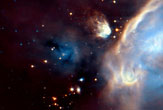
In October 2001 European astronomers located a field of young brown dwarfs in Ophiuchus, the constellation that Nibiru would move slowly into after acheiving its aphelion destination in Aquila (this occurred during the 19th Century):
"Amid space clouds stuffed with baby stars, astronomers have detected 30 difficult-to-spot brown dwarfs, failed stars that emit very little radiation. The dusty clouds are near the star rho Ophiuchi, located 540 light-years away in the constellation of Ophiucus. Nesting in these clouds are more than 100 newborn stars -- large, bright and obvious. But using the European Space Agency's Infrared Space Observatory (ISO), astronomers also detected the faint heat signatures of the brown dwarfs." (8)
The astronomers say that they will return to this star-field for a closer look at these brown dwarfs. Given the unique stellar signature of these celestial entities, one wonders whether they may inadvertently stumble across a planet-sized brown dwarf that is to be found much, much closer than these distant specimens.
Brown Dwarf Imaged Orbiting Star
For the very first time an object orbiting another star has been imaged, despite lying within the intense glare of the parent sun.
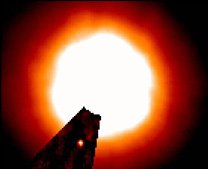
The brown dwarf is 'more than 12 times the mass of all the planets in the solar system', and is orbiting the star 15Sge at a distance of 14 Astronomical Units, equivalent to an orbit that would lie between Saturn and Uranus in our own system.
"This discovery implies that brown dwarf companions to average, sunlike stars exist at a separation comparable to the distance between the sun and the outer planets in our solar system," said University of Hawaii astronomer Michael Liu. (9)
The searches for planets orbiting other stars had thus far failed to reveal brown dwarfs, presumably as the range of orbital radius sought was limited to 4AU.
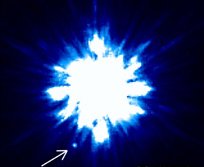
This new finding is the equivalent of an 'outer star system' planet, rather than the 'inner star system' worlds previously discovered. The sheer size of the brown dwarf orbiting 15Sge brings our knowledge of the formation of the outer planets into further doubt:
"This companion is probably too massive to have formed the way we believe that planets do, namely from a circumstellar disk of gas and dust when the star was young," Liu said in a statement. "This finding suggests that a diversity of processes act to populate the outer regions of other systems." (9)
What is more exciting about this finding is the potential for this brown dwarf to be imaged more precisely over time. Does the coronal discharge emitted by this dark star interact with the Stellar Wind moving away from 15Sge? If the brown dwarf has an anomalous appearance, then we should be able to compare this with my theoretical model for the appearance of Nibiru while at a similar distance from the Sun.
Planets around Brown Dwarfs
Scientific confirmation that planets might form around interstellar brown dwarfs, in a similar way to those that form around regular stars, emerged in 2001. Accretion discs were detected around these failed stars, some of which were as small as 10 Jupiter masses. This led to speculation that some free-floating brown dwarfs might harbour planets. Could some of them be life-supporting?
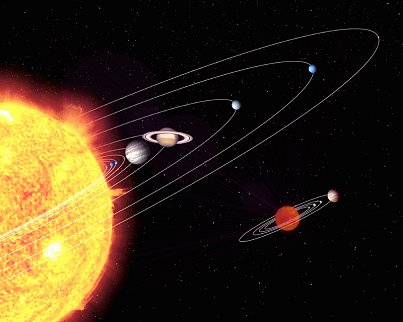
Charles J. Lada, an astrophysicist at the Smithsonian Astrophysical Observatory, thinks not. A planet at the distance of Earth around a brown dwarf would be frozen due to the smaller light and heat output of the failed star compared to our Sun, he points out. But what if the orbiting planets were at the distance of Jupiter's moons instead? Would they not then fall within the much closer 'habitable zone' of a brown dwarf? This was a question that was not addressed during the now familiar distancing of 'serious' research from the E.T. question. Still, the scientific speculation by the Smithsonian astrophysicists went much further than the normal cautious scepticism:
"As for nearby brown dwarfs, the closest free-floating brown dwarfs discovered so far (in a separate study) is about 13 light years from Earth, and researchers expect to find much closer brown dwarfs in the future, possibly within one light year of our Solar System. If brown dwarfs do in fact exist so near our Solar System, it stands to reason that they might also harbor planets. For now, the closest candidate object for harboring planets was Alpha Centauri, which is 4.3 light years away. The brown dwarf finding offers a mechanism for generating a planet just outside our Solar System." (10)
Some scientists do seem to be waking up to the possibilities. But we can actually go much further than this. During the life of the solar system, stars and interstellar brown dwarfs would have passed through the solar system, as Jack Hills calculated in 1981 (11). One may well have been captured, by the mechanism Hills described in 1985 (12). Perhaps one that was long ago given the name 'Nibiru/Marduk'.
A bit further down this page, we will read of the direct observation made in 2005 of a small Brown Dwarf's proto-planetary disc, offering compelling evidence that these failed stars come with their own planetary systems.
Orbiting Brown Dwarf Imaged
Brown dwarfs have not been found orbiting 'standard' stars within 5AU distance, but astronomers have strangely imaged one of these celestial objects orbiting a low mass star called LHS 2397a. Current theories have it that brown dwarfs are likely to be wandering objects ejected from star systems early on in their development, but this discovery indicates that this may need some revision. Why one has been found orbiting a loss mass star when they are conspicuous by their absence around Sun-like stars is anyone's guess. But this unexpected development has given astronomers a unique opportunity to photograph the brown dwarf companion.
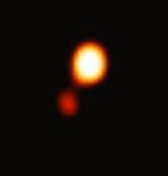
For the low level of luminosity of LHS 2397a allows the feeble light of the brown dwarf to be separated, as this remarkable image shows. What is more exciting is that the separation of this brown dwarf from the low mass star is only 3AU.
Comment that was passed on this discovery also provides some interesting reading:
"We find companions to low-mass stars are typically only 4 AU from their primary stars, this is surprisingly close together," said team member Nick Siegler, a University of Arizona graduate student. "More massive binaries have typical separations closer to 30 AU, and many binaries are much wider than this." The new Gemini observations, Close said, "imply strongly that low-mass stars do not have companions that are far from their primaries."
Similar results had been found previously by a team led by Dr. Eduardo L. Martin of the University of Hawaii Institute for Astronomy in a survey of 34 very low-mass stars and brown dwarfs in the Pleiades cluster carried out with the Hubble Space Telescope. These two surveys together clearly demonstrate that there is an intriguing dearth of brown dwarfs at separations larger than 20 AU from very low-mass stars and other brown dwarfs" (13)
Weather Patterns Might Explain Anomalous Brightness of Brown Dwarfs
Brown dwarf experts have been trying to explain why many of these objects are brighter than they should theoretically be. Common sense would dictate that as brown dwarfs cool over time, from thier inital fiery beginnings, their relative brighness should also lessen accordingly. Apparently not. Using weather models derived from Jupiter's own atmospheric system, and applying them to brown dwarfs, a model has emerged that might explain the anomaly:
"Not massive enough to sustain the burning of hydrogen, like stars, brown dwarfs go through cooling stages that scientists observe with infrared energy-detecting telescopes. They appear as a faint glow, like an ember from a fire that gives off both heat and light energy as it dims. Astronomers expected brown dwarfs, like most objects in the universe, to grow steadily fainter as they cool. However, new observations showed that during a relatively short phase, brown dwarfs appear to get brighter as they cool. The explanation lies in the clouds. At least 25,000 times fainter than the sun, brown dwarfs are still incredibly hot, with temperatures as high as 3,140 degrees Fahrenheit (2,000 degrees Kelvin). At such high temperatures, substances such as iron and sand are in gaseous form. As brown dwarfs cool, these gases condense in the atmosphere into liquid droplets to form clouds, similar to water clouds on Earth.
"As the brown dwarf cools further, atmospheric weather patterns cause a rapid clearing of the clouds; as the clouds are whisked away by the storms, bright infrared light from the hotter atmosphere beneath the clouds escapes, accounting for the unusual brightening of the brown dwarfs.
"The model developed by the group for the first time matches the characteristics of a very broad range of brown dwarfs, but only if cloud clearing is considered," Burgasser said. "While many groups have hinted that cloud structures and weather phenomena should be present, we believe we have actually shown that weather is present and can be quite dramatic."" (14)
I've often likened the appearance of Nibiru to a planet that smoulders like embers. Given the vivid description cited above, I appear to be justified in making this remark. Even if Nibiru is very old, and therefore a cool example of a brown dwarf, I think this research is helpful. After all, if Nibiru enters the solar system during perihelion, the warming it will experience as a result could readily set off immense storms in its atmosphere, and the above model might allow us to predict how that could lead to an increase in Nibiru's emission of light and heat. The planet Nibiru at perihelion would appear like a re-lit ember, apparently as a result of its clearing cloud cover!
The Phoenix Effect
If the Sun does indeed have a massive solar companion that'son the borderline between a massive planet and a small brown dwarf, then how would it appear to observers as it comes into the solar system at perihelion? The answer to that question depends very much on the age of the brown dwarf, but it is often stated that an old dwarf would be essentially extinguished. So if Nibiru, which is roughly the same age as the Sun (given that it entered the solar system only half a billion years after its creation and so probably came from the same stellar nursery), is a small brown dwarf it should be like Jupiter. So the argument goes.
Of course, we don't know this for sure, because old small brown dwarfs haven't yet been detected, being too dim capture by our current telescopes. But there are indications that we are under-estimating the potential energy output of the brown dwarfs that are little more than massive Jupiters. The recent capture of X-ray activity from the small brown dwarf TWA 5B by the Chandra telescope is a case in point:
"A Chandra observation revealed X-rays produced by TWA 5B, a brown dwarf orbiting a young binary star system known as TWA 5A. The star system is 180 light years from the Earth and a member of a group of about a dozen young stars in the constellation Hydra. The brown dwarf orbits the binary star system at a distance about 2.75 times that of Pluto's orbit around the Sun.
"Young brown dwarfs,
like young stars, have turbulent interiors. When combined with rapid rotation,
this turbulent motion can lead to a tangled magnetic field that can heat
their upper atmospheres, or coronas, to a few million degrees Celsius.
The X-rays from both TWA 5A and TWA 5B are from their hot coronas.
TWA 5B is estimated
to be only between 15 and 40 times the mass of Jupiter, making it one of
the least massive brown dwarfs known. Its mass is rather near the boundary
(about
12 Jupiter masses) between planets and brown dwarfs, so these results could
have implications for the possible X-ray detection of very massive planets
around stars" (15)
The fact that the emission is from the hot corona of the brown dwarf is also very interesting, because the shape of the corona could be subject to the stellar wind of the main star. In Nibiru's case this could lead to a cometary tail of fire in the shape of a planetary magnetosphere swept back away from the Sun on its perihelion approach. Hence the Phoenix effect. Does the image from Chandra show such an effect? Unfortunately the resolution and overall glare is a major problem to answering such a question. But this information is encouraging nonetheless.
""This brown dwarf is as bright as the Sun today in X-ray light, while it is fifty times less massive than the Sun," said Tsuboi. "This observation, thus, raises the possibility that even massive planets might emit X-rays by themselves during their youth!" This research on TWA 5B also provides a link between an active X-ray state in young brown dwarfs (about 1 million years old) and a later, quieter period of brown dwarfs when they reach ages of 500 million to a billion years." (16)
These certainly are interesting times...
From the Horse's Mouth
For a little while I have been working closely with a researcher called Rajasun. Although he is not an academic astronomer, his long-term interest in the idea of our solar system being a 'binary' has propelled him headlong into the study of astrophysics. Recently, he wrote to one of the foremost experts on brown dwarfs, J.D. Kirkpatrick, and asked, amongst other things, whether an old, small brown dwarf was still capable of 'flaring'. It now seems that if, for instance, Nibiru was a small brown dwarf of a similar age to our Sun, then one might still expect flaring "because of the intense surface gravity which consequently affects magnetic activity on the brown dwarf" (Raja's words).
Raja: "Is the incidence/frequency of X-ray flares directly related to Age and Teff of a BD [brown dwarf]? Is there a relationship between the reduction of X-ray flaring activity and increased radio flares on BDs (i.e. decreasing X-ray flaring leading to increase incidence of Radio flares)?"
J. D. K. "That's precisely what we've been trying to determine, but the brown dwarf community hasn't received much time to investigate these issues using telescopes like Chandra and XMM. Keep in mind that part of our inability to answer this question comes from the fact that brown dwarfs, even when flaring, are pretty darned faint in X-rays. Chandra and XMM have been reluctant to give time for these projects because most brown dwarfs will be totally invisible at X-ray wavelengths unless you get lucky and happen to catch one during a flare."
Dr Kirkpatrick kindly recommended this helpful artist's rendition of brown dwarf types:
"All objects are plotted to the same scale. On the far left is the limb of the Sun. To its right is shown a very low mass star (a so-called "late-M dwarf"), a couple of brown dwarfs (a hotter "L dwarf" and a cooler "T dwarf"), and the planet Jupiter. These objects have masses ranging from 1050 times that of Jupiter (for the Sun) through 75, 65, 30, and 1 Jupiter mass for the late-M dwarf, L dwarf, T dwarf, and Jupiter, respectively. The colors of the brown dwarfs are chosen to match an age of 1 billion years. Despite the range in mass, all four of the low-mass objects are approximately the same size, ten times smaller than the diameter of the Sun. [This image] shows how these objects might appear to the human eye: the M and L dwarfs are red, while the T dwarf is dimly magenta, due to lack of light -- actually absorptions by sodium and potassium atoms -- in the green portion of the spectrum." (17)
He also recommended a recent paper by Adam Burrows, et al, regarding theoretical modelling of brown dwarfs. It had these remarkable lines in its extract:
"These changes suggest physical reasons to expect the emergence of at least one new stellar class beyond the T dwarfs. Our spectral models populate, with cooler brown dwarfs having progressively more planet-like features, the theoretical gap between the known T dwarfs and the known giant planets. Such objects likely inhabit the galaxy, but their numbers are as yet unknown." (18)
All of which seems to suggest that old brown dwarfs cannot simply be consigned to the dustbin of planethood. There is a growing flexibility built into these considerations that allows for planet-like old brown dwarfs with remnant stellar characteristics. This would readily fit the picture of a binary companion to our Sun that had so far evaded detection, but was yet capable of quite a few surprises.
Nibiru-like Binary Discovered
The chance discovery of a binary brown dwarf system has increased the potential for a similarly widely separate binary system for our Sun. The two brown dwarfs are separated by about 240 AU, or 240 times the distance between the Sun and the Earth. This would relate to a semi-major axis distance for an orbit of 3500 years, similar to that envisioned for Nibiru. This is a very rare find, and breaks the mould for such binary systems, which tend to be separated distances that are a fraction of this. Astronomers are generally sceptical about finding planets at this distance, because they believe that the orbits would be easily subject to perturbation, and the binaries would break down.
This discovery must bring this long-held belief into question. The discovery was made by Kevin Luhman, from Harvard University, Massachusetts. Seeking young brown dwarf for study he trained the Magellan telescopes at Chile's Las Campanas Observatory on a star cluster 540 light years away in the Chameleon constellation. He found a binary pair of brown dwarfs, and this discovery has subsequently re-opened the debate about how brown dwarfs form.
"Calculations showed that the two brown dwarfs were orbiting each other at 240 times the distance between the Earth and Sun, a distance 10 times greater than other brown dwarfs pairs. Since even the slightest tug could upset this fragile balance, Luhman suggests the pair could not have formed from a violent ejection. Instead, they must have formed in a slow gravitational collapse, like stars.
"Gibor Basri, an astronomer at the University of California, Berkeley, and one of the early pioneers of brown dwarf research, agrees. "The distance between most other binaries is very small. The extremely large separation in this binary shows that the same process that formed stars extends to bodies of low mass as well." " (19)
Other recent scientific findings suggest that the Sun did indeed once have a large body in orbit around it, larger than a Jovian planet. This discovery shows that a binary with a brown dwarf can form at this distance, and remain stable. Which would suggest that the presence of an ancient brown dwarf companion to the Sun need not have been lost over time. It may still be out there, and it may describe an orbit that is tantalisingly close to that of the mythical Nibiru.
Small Brown Dwarfs have their Own Planets
'New Scientist' has reported on a remarkable discovery about the formation of a planetary system around a small Brown Dwarf. Because the glare of the Brown Dwarf is so much smaller than that of 'regular' stars it was possible to directly image material in a disc around it. Some of this material was clumping indicating planet formation. It is thought that the total mass of the proto-planetary system orbiting a Brown Dwarf would be equivalent to about 10% of the Dwarf's own mass. That provides enough material to form a Saturn-like planet, as well as a number of terrestrial worlds.
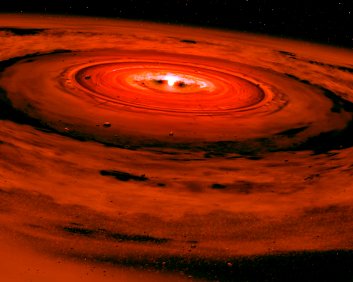
The Brown Dwarf in question lies about 500 light years away in the sky region known to astronomers as Chamaeleon I, which is a known stellar nursery. The disc was observed by the Spitzer telescope, appearing relatively bright in the infra-red part of the spectrum. The finding has fuelled speculation in the scientific community that life-supporting planets might be discovered around Brown Dwarfs:
"The surface temperature of the mini brown dwarf is about 2000°C, which means that any planet 1.5 to 7 million kilometres away could maintain liquid water. The disc probably straddles this range" (20)
Not only that, but discovering such worlds in these kinds of systems might actually be easier than looking for planets in more classical star systems, where the glare of the stare makes it very difficult to image much of anything in its immediate vicinity. Just recently a massive planet was imaged orbiting a brown dwarf (21).
The scientific team, led by Kevin Luhman of the Harvard-Smithsonian Center for Astrophysics in Cambridge, Massachusetts, US, hopes to extend its search to even smaller brown dwarfs to see how small they can get yet still allow planetary formation.
Not only does this research raise questions about how star and their planetary systems develop, but it also opens the door to more urgent speculation about the nature of a binary Brown Dwarf Companion in our own Solar System, should such an object be discovered in the future. The potential for life to have developed in such a system is increasing; at least, that is the verdict of science!
Brown Dwarf 'Sun' Finding
As has already been mentioned on this page, brown dwarfs are massive planets that have accreted many times the amount of mass than Jupiter. Yet they remain approximately the same size. Instead, the weight is confined to an area roughly the size of Jupiter, and this makes them increasingly dense. This, in turn, makes their activity levels so much greater than mere gas giants like Jupiter as their surface gravity builds and builds with greater and greater mass.
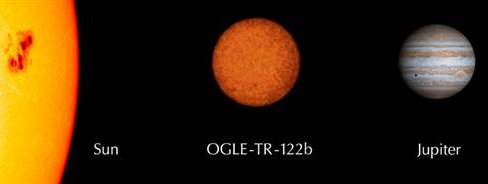
Although this general idea was accepted, it was still thought that the brown dwarfs would naturally increase in size as they moved towards a more typical dwarf star, like a red dwarf. However, scientists on the OGLE program have analyzed one particular binary brown dwarf, which is closely orbiting a Sun-like star towards the centre of the Milky Way, that is off the charts. They have discovered, to their surprise, that this binary companion shines like the Sun, yet is only 16% larger than Jupiter (22).
This is amazing, because the binary companion is 50 times as massive as Jupiter, making it very dense indeed (23). Previously, brown dwarfs of this magnitude were imagined to be much larger objects.
What is most surprising about this discovery is that this 'sub-stellar object' is simultaneously in the mass range of the brown dwarfs, shines like the Sun but is the size of a regular planet! How mixed up is that? Which, of course, goes to show that there are many, many possibilities to these brown dwarf objects.
This here is a Dark Star that isn't even remotely dark...
Young Brown Dwarfs emit Massive Jets
As time goes on, the consensus within the scientific community appears to be that brown dwarfs form more like stars than planets. They have been observed to have dusty disks of their own, and now have been seen to emit hot jets of material, in a similar way to more regular stars during the celestial birthing stage:
"Researchers, led by Emma Whelan of Ireland's Dublin Institute for Advanced Studies (DIAS), have observed a jet stretching 1.5 billion kilometres from a young brown dwarf in a stellar nursery called Rho Ophiuchi. Similar jets have been detected around young, massive stars and are thought to form from material in the disc that swirls around them. The stars grow when matter falls on them from the disc, but the stars' magnetic fields funnel about a tenth of that matter back through the jets. This observation of a jet, combined with an indirect detection of an apparently large disc around the brown dwarf, suggests "they form like ordinary stars rather than being ejected", says team member Thomas Ray of DIAS. "But it might end up that brown dwarfs form by two methods."" (24)
This has implications for the Dark Star Theory. Firstly, it increases the likelihood that a brown dwarf embedded in the Solar System would have developed as a star-like entity in its own right. It may have done this as a loosely bound binary companion to the Sun, within a fairly densely packed stellar nursery. This makes good sense anyway, because the chance of the Sun capturing an interstellar companion in the form of an ejected planet-like brown dwarf is quite remote. At least on a statistical level. This loosely bound binary companion's orbit may have altered over time, bringing it into close proximity to the Sun's planetary zone at some point (probably during the 'late, great bombardment' about 3.9 billion years ago). Hence, it played a part in shaping the Sun' planetary system, creating the various anomalies we find today.
The jets of material ejected by young brown dwarfs also serve to indicate the remarkable activity levels of these objects, and the real potential for star-like qualities for even old-ish brown dwarfs, like the own potentially orbiting our star. I suspect they have generally been underestimated.
Young Brown Dwarfs have Proto-planetary Discs
Are brown dwarfs planets or stars, or a bit of both? They increasingly resemble stellar class objects, and this has been highlighted by the discovery of proto-planetary discs around several classic brown dwarfs in the Chamaeleon constellation.
"The astronomers discovered that five of the six disks contain dust particles that have crystallized and are sticking together in what may be the early phases of planet assembling. They found relatively large grains and many small crystals of a mineral called olivine.
""We are seeing processed particles that are linking up and growing in size," said Dr. Ilaria Pascucci, a co-author also of the University of Arizona. "This is exciting because we weren't sure if the disks of such cool objects would behave the same way that stellar disks do." The team also noticed a flattening of the brown dwarfs' disks, which is another sign that dust is gathering up into planets." (25)The potential for the study of planets forming in brown dwarf star systems is huge.
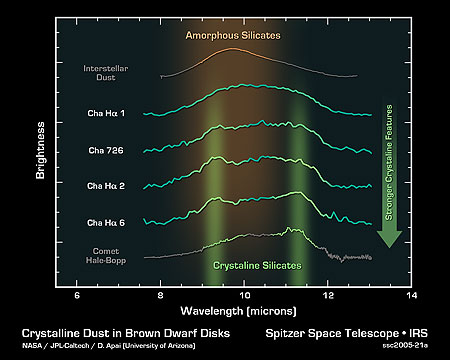
Firstly, it is thought that brown dwarfs are as numerous as traditional stars. Secondly, in the case of a brown dwarf system, the reflected light from candidate planets orbiting brown dwarfs would not be so overwhelmed by the brilliant light of the parent star. This would make it easier to differentiate smaller planets in this kind of dwarf system, and to analyse the composition of planetary atmospheres. Thirdly, undiscovered brown dwarfs may well lurk between here and the nearest stars, offering the potential for the discovery of closer planets than previously thought.
Might a brown dwarf companion to the Sun remain undiscovered, with its own system of planets? This new evidence at least suggests that if a companion is out there, then it is probably not alone...
· "Dumping more mass on a brown dwarf doesn’t make it bigger, it just makes it denser. A 70-Jupiter-mass and 20-Jupiter-mass brown dwarf are both about the size of Jupiter.
· From up close, a young brown dwarf would look like a low-mass star, but an old brown dwarf would look more like Jupiter.
· Brown dwarfs aren’t brown, they would look red to the naked eye.
· Brown dwarfs radiate most of their energy in infra-red light.
· There’s a 50:50 chance that a brown dwarf lurks within 4 light-years, the distance to the sun’s nearest stellar neighbour.
· Some brown dwarfs spin so fast that they complete one rotation in less than an hour.
· Planets have rock-ice cores; brown dwarfs have hydrogen cores.
. The average density of a brown dwarf is about 70 grams per cubic centimetre, which is 5 times the density at the centre of the Earth." (1)
Written by
Andy
Lloyd, 2000 - 2005
author of 'The Dark Star'
(2005), 'Ezekiel One'
(2009), 'The Followers of
Horus' (2010) and 'Darker Stars' (2019)
References:
1) Robert Naeye ‘Astronomy’ Aug 1999, p36-42
2) Carl Sagan "Pale Blue Dot: A Vision of the Human Future in Space " p392 Headline Book Publishing
3) Correspondence from Mark Marley, 28 January 2000
4) David Griffin "How can we detect Brown Dwarfs?" 1998
5) ESO press release "A Faint and Lonely Brown Dwarf in the Solar Vicinity" 28 April 1997
6) Thanks to James Monds
7) Reuters, 11 July 2000, By Deborah Zabarenko, Washington
8) "Nest of Elusive Brown Dwarfs Seen in Stellar Nursery" Space.com 25 October 2001 (No longer available online) thanks to JJK and Damon Elkins
9) Richard Stenger "Object near sunlike star caught on camera" 7 Jan 2002, with thanks to Allene Keller and Theo
10) R. Britt "Dark Planets May Orbit Strange Nearby Objects" Space.com 7th June 2001, (No longer available online) painting by B. Scott Kahler
11) Jack Hills "Comet showers and the steady-state infall of comets from the Oort cloud", Astronomical Journal, 86: 1730-1740, Nov 1981
12) Jack Hills "The passage of a 'Nemesis'-like object through the planetary system" Astronomical Journal 90: 1876-1882, September 1985
13) "Brown Dwarf Found Orbiting Star at Earth-like Distance" Cosmiverse.com (No longer available online) with thanks to Brant McLaughlin and David Pearson
14) Astronomers Find Jupiter-Like Weather On Brown Dwarfs 23rd May 2002 Thanks to Brant
15) "TWA 5B: X-Rays Found From a Lightweight Brown Dwarf" With thanks to James Monds
16) "X-rays found from a lightweight brown dwarf"
17) "An Artist's View of Brown Dwarf Types" Dr. Robert Hurt of the Infrared Processing and Analysis Center
18) Adam Burrows et al. "Beyond the T Dwarfs: Theoretical Spectra, Colors, and Detectability of the Coolest Brown Dwarfs", The Astrophysical Journal, Volume 596(1): 587 April 2003, with thanks to J.D. Kirkpatrick and Rajasun
19) Amitabh Avasthi "Brown Dwarfs win Star Status" 9th July 2004 With thanks to David Pearson
20) Hazel Muir, "Brown dwarf may someday harbour habitable planets" New Scientist 8th February 2005, with thanks to Peter Gersten
21) Spitzer ST Press Release 'Astronomers discover beginnings of 'mini' Solar System' 7th February 2005 With thanks to Monika Myers and James Monds
22) The Guardian "Hot Star Shines in Tiny Role" p11, 5th March 2005
23) Robert Roy Britt "Newfound star smaller than some planets" 3rd March 2005
24) Maggie McKee Violent jet detected spewing from brown dwarf" 24/6/05 , with thanks to Shad Bolling and David Pearson
25) NASA "NASA's Spitzer Finds Failed Stars May Succeed in Planet Business" 20th October 2005 With thanks to Monika, David and Peter
![]() 'Brown Dwarfs' Available in Italian
'Brown Dwarfs' Available in Italian
![]() 'Brown Dwarfs' Available in Spanish
'Brown Dwarfs' Available in Spanish